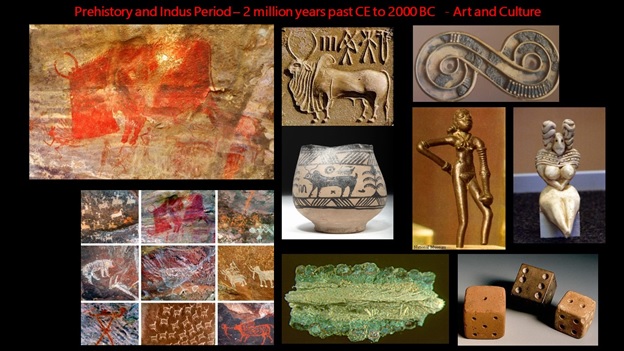India: Pre-history to Indus Period – Art and Culture
The earliest ‘culturally conscious’ Indians belonged to the H. erectus communities of the Middle Paleolithic period, who created the ‘Nevasan’ (and Soan) cultures 500,000 years ago. Sites for this culture are spread all over India and yield siliceous ‘flake stones’ and ‘axe-cleavers’, with rituals guiding life and death. Around 130,000 years ago, these axe wielding hunter-gatherer hominids began occupying the ‘Bhimbhetka’ caves of central India (approx. 750 rock shelters over 10 km) which became one of the few continuously maintained ‘cultural’ landmarks well into recorded history.
The H. sapiens culture begins around 60,000 years ago, with the rise of the Mesolithic cultures. These sites (like Sarai Nahar Rai and Mahadaha in Uttar Pradesh) are marked with large burial sites, ritualistic burial remains, bone ornaments, bone figurines and engraved ostrich-egg shells. Bones of domesticated animals like dogs, cattle, pig and deer indicate a transition from hunter-gatherers to a pastoral life.
Around 8000 BCE, handmade pottery and rock wall paintings start to appear at the Bhimbhetka site. The paintings depict wild and domesticated animals, hunting scenes, dancing and other ritualistic social activities, along with ‘astronomy’ observations; they show great artistry and vision, indicating a thriving ‘tribe’ culture. Recently, the first ever larger than life sized petroglyphs have been discovered in the Konkan coast area depicting animals, a ‘master of animals’ figure and abstract designs.
By 7000 BCE, the earliest agriculturist settlement of the subcontinent is noted in Mehrgarh (Balochistan), marking entry into the Neolithic period with the first use of copper and large granaries for barley, wheat, jujube and date harvests.
This agrarian society of Mehrgarh (Copper Age) developed into the technologically advanced Bronze Age culture of the Indus Valley civilization. Though the mature Indus civilization spans from 3300BC to 1700BC, some Indus sites like Rakhigarhi had existed since 5000BC.
All major sites of the Indus culture, including Harappa, Mohenjo Daro, KotDiji, Kalibangan, Ganeriwala, Dholavira, depict an organized, sophisticated and modern city-culture, with highly standardized town planning and advanced architectural feats, with systematized street and drainage designs.
Despite their agricultural and cattle-rearing practices, the Indus civilization was primarily a ‘commerce’ culture. Its urban centers controlled a flourishing trade-dependent economy. Hallmarks of this distinct culture include widespread trade, and use of terracotta (bricks and pottery), bronze and copper, precious metals, semiprecious stones and mix material beads.
This orderly commercial culture boasts the first use of a highly sophisticated terracotta and steatite plaque system of identification (of goods, persons, groups, locations, even commemorative plaques of events), with an inscription system (the Harappan script) that has yet to be meaningfully deciphered.
Socially, the Indus people maintained a hierarchical setup, similar to that of contemporary ‘civilizations. Equal significance was given to ritualistic, mercantile and cultural activities in their daily lives. Various origin myths, and reverence to the Mother Goddess as the source of creation (from earlier agrarian cultures), continued into this era. Nature motifs such as trees, animals and fish appear to be popular themes in the seals and artifacts from this period. Cosmology of the mother goddess and nature worship still continues as a cultural myth in India.
A tasteful artistic inclination is noted, with widespread production of statues (including dancers) and toys of varying dimensions in terracotta and bronze, musical instruments (seven-holed flute, string instruments), delicate painted pottery (including burial jars), ivory carvings, gold and mother-of-pearl ornaments and extensive bead production (with the earliest imports of lapis lazuli and carnelian). Extensive hoard of jewelry (which appear to have passed through generations), clay toys and ‘game’ artefacts (dice) have been recovered from houses of rich merchants.
The cultural significance of textile developed steadily, with use of finely patterned fabric of wool, hemp/jute fibers, and even silk. Most significantly, Indus people are already growing, weaving and dyeing cotton, setting precedence for the great Indian textile tradition.
References :
1. A History of Ancient and Medieval India. Upinder Singh. 2018 impression.
2. The Wonder that was India. A.L. Basham. 3rd edition.
3. The Civilisation of India. R.C. Dutt.1995
4. Cultural History of India. O. Prakash.2004
5. A People’s History of India. Prehistory. I. Habib, V.K. Thakur. 10th Edition.
6. https://kevinstandagephotography.wordpress.com/2019/03/14/the-konkan-petroglyphs-introduction/

Fig. Left Panels : Prehistoric Cave paintings at Bhimbhetka site depicting the Great Indian bison, elephants, deer and hunting scenes.
Centre and Right : In anti-clock wise direction- continuation of the tradition of Bison symbolism on Harappan clay seals (signed with Harappan script) and pottery, the only surviving piece of textile, clay dice (toys), female figurines (the Bronze dancing girl of Harappa and terracotta Mother Goddess from Mehrgarh), Steatite and semi-precious stone brooch from Mohenjo Daro.
Dr Krishakali Dasgupta leads the Arts and Culture track in India Discovery Center'sproject on "Evolution of Indian Culture: Pre-history to 1947AD".
More information and updates on the project are available at
Information on India Discovery Center is at
(c) Copyright 2020 India Discovery Center, Inc. All Rights Reserved.



